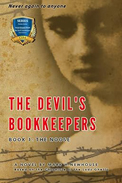
 |
This is historical fiction at its best. Newhouse describes Polish ghetto life circa the early 1940s. The book is accurate, fast-paced, and riveting. It reads like a mystery novel, making the horrors of the Lodz Ghetto easier to read and learn about. The story describes starvation, freezing temperatures, poor healthcare, and a hierarchy amongst the Jewish inhabitants/prisoners.
Part of the tension within the Lodz Ghetto was the fact that some Jews enjoyed more privileges than others. For example, those at the top of the command structure ate better, dressed better, and lived better than the rest of the suffering population, causing hostility between the people and their "government." In particular, Chaim Rumkowski, head of the Nazi-appointed Judenrat, brutally enforced Nazi decrees. However, as the author notes, there was also “love and a hunger for life, courage, and sacrifice.” The horrors of the Lodz Ghetto are softened in the story by the portrayal of a man and wife trying to survive and make a life for themselves. The main character’s deep love for his wife and child illustrates the undying devotion and grit of the Jewish people in the ghetto.
The author's parents were among the few to survive the Ghetto. Newhouse skillfully writes this story in their honor, spinning a tale around the facts from The Chronicle of the Lodz Ghetto, 1941-1944, a book the author encourages everyone to read. When it comes to writers of Jewish historical fiction, Leon Uris is often viewed as the standard. Newhouse is in the same league. There is more to learn about the Holocaust than The Diary of Anne Frank. This book would be excellent mandatory high school reading, and students would undoubtedly move right on to the second two books in the series while passing this one on to their parents as "required reading."
RECOMMENDED by the US Review